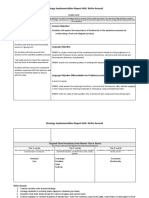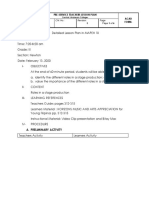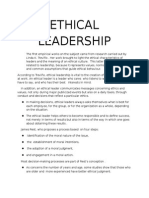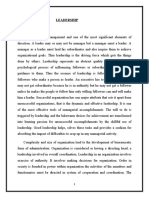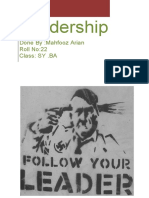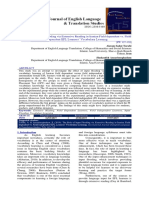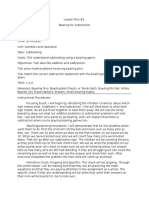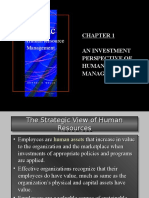Professional Documents
Culture Documents
History of Leadership Sutdies
History of Leadership Sutdies
Uploaded by
nkd000Copyright
Available Formats
Share this document
Did you find this document useful?
Is this content inappropriate?
Report this DocumentCopyright:
Available Formats
History of Leadership Sutdies
History of Leadership Sutdies
Uploaded by
nkd000Copyright:
Available Formats
The History of Leadership Studies and Evolution of Leadership Theories
While leadership has been a topic of interest since the dawn of man, leadership and management studies were taken up in earnest in the early 20th century. This hub chronicles a kind of evolution in leadership behavior studies from the traits of effective leaders to follower-centered leadership theories proposed in the late-20th, early 21st century. Much of the credit for the information in this hub go to Dr. Peter Northouse and Dr. Gary Yukl and their respective publications Leadership: Theory & Practice and Leadership in Organizations. Through these important works each man has contributed greatly to the understanding of leadership behaviors within organizations. This brief survey is not meant to be exhaustive by any means.
Frederick Winslow Taylor
Source: Frederick Winslow Taylor
Frederick Winslow Taylor - Scientific Management
In the early 20th century, Frederick Winslow Taylor proposed the practice of scientific management. This is not a leadership theory per se but changed the way leader-managers interacted with employees and handled production of a given product. Through his own work experience and informal education, Taylor recognized that employers could get the most out of their workers if they broke labor projects into their various parts and trained laborers to specialize in each particular station of production. Taylor timed each part of the production process in order to improve
production to maximum efficiency. In terms of leadership within organizations, Taylor believed that leaders were born, not made and assumed there was only one form of effective leadership.
Stogdill's Handbook of Leadership
Great Man and Trait Theory
Leadership studies in the early part of the 20th century focused on what has been referred to as Great Man and trait theories. Great man theory of leadership proposes that certain men are born to lead and when crises arise these men step up to take their natural place. This theory was also related to trait theory. Trait theory proposes that only men with the in-born characteristics for leadership will be successful leaders. The search was for the right combination of characteristics that would lead to effective leading of organizations. Through two meta analytical surveys of 124 previous studies in 1948 and 163 others in 1974, R.M. Stogdill identified a list of 10 best traits and skills of effective leaders. The 1974 list included 1. drive for responsibility and task completion 2. vigor and persistence in pursuit of goals, 3. venturesomeness and originality in problem-solving, 4. drive to exercise initiative in social situations, 5. self-confidence and sense of personal identity, 6. willingness to accept consequences of decision and action,
7. readiness to absorb interpersonal stress, 8. willingness to tolerate frustration and delay, 9. ability to influence other persons' behavior, 10. capacity to structure social interaction systems to the purpose at hand.
Kurt Lewin
Lewin's Leadership Styles
Kurt Lewin worked with colleagues Lippett and White to pen the 1939 publication, Patterns of aggressive behavior in experimentally created social climates. In that work, Lewin et al. propsed three leadership types displayed within organizations. Those leadership styles included: 1. Autocratic leadership whereby the corporate leader made all decisions without consultation. 2. Democratic leadershipwhereby the leader-supervisors included members of the organization in the decision-making process. 3. Laissez Faire leadershipwhereby the leader played a minimal role in the decision-making process.
Max Weber
Source: Max Weber
Charismatic Authority
Max Weber, a German sociologist, was the first to propose and describe Charismatic authority (the precursor to charismatic leadership theory) in his work The Protestant Ethic and the Spirit of Capitalism. Weber described Charismatic leadership as "a special personality characteristic that gives a personexceptional powers that result in the person being treated as a leader. House (1976) published a theory of charismatic leadership within which he described the personal characteristics of this type of leader as being dominant, having a strong desire to influence others, being self-confident, and having a strong sense of ones own moral values (Northouse, 2004).
Dr. Fred Fiedler
Contingency Theory of Leadership
The 'Taylorists' believed there was one best style of leadership and that that style fit all situations. Fred Fiedler in various works came to believe that best leadership style was the one that best fit a given situation. Accordingly, Fiedler proposed the Contingency Theory of Leadership and the Least Preferred Coworker Scale to establish whether a particular manager-supervisor was a good match for his leadership assignment.
Rensis Likert
Participative Leadership Theory
Participative Leadership has been proposed and highlighted by a number of scholars including Dr. Rensis Likert (1967) and Gary Yukl (1971). Likert is best known for the Likert Scale, a measurement devise used to measure degrees of acceptance of a given premise. His theory of leadership styles included the following. Likert Leadership Styles 1. Exploitative authoritative - by which the leader shows little if any concern for his followers or their concerns, communicates in a demeaning, accusatory fashion, and makes all decisions without consultation with the subordinates. 2. Benevolent authoritative - is concerned with the employees and rewards for quality performance, but makes all decisions alone. 3. Consultative - makes genuine effort to listen to the subordinates' ideas, but decisions are still centralized in the leader. 4. Particpative - shows great concern for employees, listens carefully to their ideas, and includes them in the decision-making process. Participative Leadership Yukl described a similar participative leadership style but used different labels. 1. Autocratic - makes all decisions alone without concern for or consultation with followers 2. Consultation - leader asks for opinions and ideas from subordinates but makes decisions alone. 3. Joint Decision - leader asks for ideas from subordinates and includes them in the making the decision. 4. Delegation - manager-supervisor gives a group or individual the authority to make decisions.
Leader-Member Exchange Theory
Leader-Member Exchange Theory (LMX) has been discussed extensively by a number of organizational behavioral scientists including Dansereau, Graen, and Haga, 1975; Graen & Cashman, 1975; and Graen, 1976. LMX is based on social exchange theory and focuses the quality of relationships and interactions between leaders and followers. Organizational scholars showed that leaders develop separate exchange relationships with each subordinate as the each party mutally defines the subordinates role. According to Graen & Uhl-Bien as highlighted by Gary Yukl, higher quality exchanges between supervisors ans subordinates result in 1. less turnover 2. more positive performance evaluations 3. higher frequency of promotions
4. greater organizational commitment 5. more desirable work assignments 6. better job attitudes 7. more attention & support from the leader 8. greater participation 9. faster career progress
Dr. Paul Hersey and Dr. Ken Blanchard
Dr. Paul Hersey
Dr. Ken Blanchard
Situational Leadership
Situational leadership theory was proposed by Dr. Paul Hersey and Dr. Ken Blanchard. By there conceptualization, leaders choose the leadership style based on the maturity or developmental level of the follower. Their theory yielded a four quadrant configuration based on the relevant amounts of directive and or supportive needed to motivate a given employee to fulfill a given task. The four quadrants are labeled according to the corresponding leadership style related to each of the four sections of the model. 1. Directing is aimed at the least mature employee or member whereby the leader uses only directive words and no supportive behaviors to motivate the employees. 2. Coaching whereby leader-supervisors use both high directive and high supportive words and behaviors in their interaction with employees. 3. Supporting whereby leader-supervisors refrain from directive behaviors and concentrate on on supportive behaviors only. These employees work well on their own but lack self confidence or may be overwhelmed with a new task. 4. Delegating whereby leader-supervisors no longer need to offer directives or supportive words and behaviors. These employees have matured to the place where they are competent and confident in the task and do not need anyone to look over their shoulders.
Path-Goal Theory of Leadership
Path-goal theory was developed by Martin G. Evans (1970) and Robert J. House (1971) and based on Victor Vroom's Expectancy Theory. The main underlying assumption is that subordinates will be
motivated if (a) they think they are capable of the work (or high level of self-efficacy); (b) believe their efforts will result in a certain outcome or reward; and (c) believe the outcome or reward will be worthwhile. Path-goal theory is said to emphasize the relationship between 1. the leader's style 2. the follower's personality characteristics 3. the work environment or setting. Like situational leadership, leaders choose between four primary leadership behaviors when interacting with subordinates, including 1. directive 2. supportive 3. participative 4. achievement-oriented wherein the leader sets high standards of excellence and seeks continuous improvement. According to the purveyors of this leadership theory, leadership motivates followers when 1. the leader increase the number and kinds of payoffs 2. makes the path to the goal clear through coaching and direction 3. removes obstacles and road blocks 4. makes the work more satisfying.
Dr. Robert Greenleaf
Larry Spears
Servant Leadership
Robert Greenleaf (1970 and 1977) published a set of essays proposing a new type of leadership focused on the follower. That leadership type is servant leadership. Greenleaf's ideas on this new type of leadership did not truly catch on however until the mid-1990s when Larry Spears dissected Greenleaf's ideas. Spears gleaned from Greenleaf's writings 10 proposed characteristics of servant leaders: 1. Listening 2. Empathy 3. Healing 4. Awareness 5. Persuasion 6. Conceptualization 7. Foresight 8. Stewardship 9. Commitment to the growth of the people 10. Building community Since Spears delineated these characteristics in 1995, a host of leadership researchers postulated conceptual models of servant leadership. More impetus for discovering and promoting more ethical
forms of leadership was given in the aftermath of repeated ethical failures within large brand name organizations within the US in the first decade of the 21st century.
James McGregor BUrns and Bernard Bass
Dr. James McGregor Burns
Dr. Bernard Bass
Transformational Leadership
Transformational Leadership has been the most widely researched form of leadership from the 1980s to 2011. Transformational leadership was first described by James McGregor Burns and then expounded upon by Bernard Bass. Burns wrote of this form of leadership in his important 1978 workLeadership in which he contrasts the characteristics of transformational leadership with transactional leadership. Transformational leadership refers to the process whereby an individual engages with others and creates a connection that raises the level of motivation and morality in both the leader and the
followers. Bass explained that transformational leadership was centered in the followers and motivates followers to do more than was expected by: 1. Raising followers' level of consciousness about the importance of organizational values and goals 2. Getting followers to transcend their own self-interest for the sake of the team or organization 3. Moving followers to address higher-level needs Bass, in his 1985 publication Leadership and Performance beyond Expectation,broke transformational leadership into four concepts including 1. Idealized Influence whereby the leader-supervisr acts like a role model of ethical behavior and gains respect and trust. 2. Inspirational Motivation whereby the leader communicates high expectations and inspires the crew to reach higher 3. Intellectual Stimulation whereby the follower-subordinates are stimulated to think outside the box, be creative and innovative
You might also like
- Week 5 - Assignment - Stem Lesson Plan-1Document10 pagesWeek 5 - Assignment - Stem Lesson Plan-1api-549067802100% (1)
- SHARE Strategy Implementation Report 6A Write-AroundDocument5 pagesSHARE Strategy Implementation Report 6A Write-AroundNikos Stathopoulos60% (5)
- Free Hogan Personality Inventory - HPI OnlineDocument1 pageFree Hogan Personality Inventory - HPI Onlinerivai anwarNoch keine Bewertungen
- Detailed Lesson Plan in MAPEH 10 Roles in Stage ProductionDocument6 pagesDetailed Lesson Plan in MAPEH 10 Roles in Stage ProductionJeenica Palcone80% (5)
- Annotated Bibliography: Applied Psychology, 88 (2) : 207-218Document3 pagesAnnotated Bibliography: Applied Psychology, 88 (2) : 207-218Joshua MamouneyNoch keine Bewertungen
- Nadler Tushman V. Boleman Deal ModelDocument13 pagesNadler Tushman V. Boleman Deal ModelVasundhara TrivediNoch keine Bewertungen
- Ethical LeadershipDocument6 pagesEthical LeadershipcheshtaaNoch keine Bewertungen
- Bass Et Al 2003 PDFDocument12 pagesBass Et Al 2003 PDFadivinhoeuNoch keine Bewertungen
- Leadership Interview Paper - 6020Document6 pagesLeadership Interview Paper - 6020api-318999873100% (2)
- Warrick 1981 Leadership Styles and Their ConsequencesDocument18 pagesWarrick 1981 Leadership Styles and Their ConsequencesSaulo André MarcosNoch keine Bewertungen
- 5 Different Types of Leadership Styles: by Rose JohnsonDocument2 pages5 Different Types of Leadership Styles: by Rose JohnsonMira Tiqah100% (1)
- Betty Neuman (System Model) 2007Document16 pagesBetty Neuman (System Model) 2007ladylisette100% (1)
- 18 Sept 2014 SPLD Handout L ReganDocument3 pages18 Sept 2014 SPLD Handout L Reganahmed samirNoch keine Bewertungen
- The Development of Leadership During The 20th Century and The Formation of Different Leadership TheoriesDocument10 pagesThe Development of Leadership During The 20th Century and The Formation of Different Leadership TheoriesRichard Christopher BorneaNoch keine Bewertungen
- The Importance of TeamsDocument2 pagesThe Importance of TeamssymhoutNoch keine Bewertungen
- Literature ReviewDocument41 pagesLiterature ReviewMunguongeyo IvanNoch keine Bewertungen
- LEADERSHIPDocument90 pagesLEADERSHIPkrishnasree100% (1)
- Concepts of LeadershipDocument22 pagesConcepts of LeadershipmustafarhNoch keine Bewertungen
- A Limo Metcalfe Leadership Time For A New DirectionDocument21 pagesA Limo Metcalfe Leadership Time For A New DirectionMark PitNoch keine Bewertungen
- The Impact of Leadership Styles On Organizational PerformanceDocument9 pagesThe Impact of Leadership Styles On Organizational PerformanceAnwar WarraqNoch keine Bewertungen
- 10.women LeadershipDocument26 pages10.women LeadershipAbhir Raj ShrivastavaNoch keine Bewertungen
- Chapter 2Document43 pagesChapter 2Nathan MontgomeryNoch keine Bewertungen
- Chapter 2 Leadership Trait Approach PDFDocument38 pagesChapter 2 Leadership Trait Approach PDFPastort Tewodros TsegaNoch keine Bewertungen
- Leadership and Leadership StylesDocument11 pagesLeadership and Leadership StylesAlia AlketbiNoch keine Bewertungen
- From Mahatma Gandhi To Winston Churchill To Martin Luther KingDocument6 pagesFrom Mahatma Gandhi To Winston Churchill To Martin Luther KingAbhisht PandeyNoch keine Bewertungen
- Educational Management Administration & Leadership-2014-Minckler-School Leadership ThatDocument23 pagesEducational Management Administration & Leadership-2014-Minckler-School Leadership Thatalanz123Noch keine Bewertungen
- Kyra Bartolomei: By, Ehow ContributorDocument5 pagesKyra Bartolomei: By, Ehow ContributorAngelie_Baral_3868100% (1)
- Leadership Theories and ModelsDocument59 pagesLeadership Theories and Modelsantony omondiNoch keine Bewertungen
- Situational Approach LeadershipDocument12 pagesSituational Approach LeadershipSaracindy SacinNoch keine Bewertungen
- Teams & GroupsDocument10 pagesTeams & GroupsRajiv SinghNoch keine Bewertungen
- What Is A Formal LeaderDocument4 pagesWhat Is A Formal LeaderSaumya DivediNoch keine Bewertungen
- Morgeson Humphrey 2006 The Work Design Questionnaire WDQDocument19 pagesMorgeson Humphrey 2006 The Work Design Questionnaire WDQDaniel RileyNoch keine Bewertungen
- LeadershipDocument15 pagesLeadershipMSKNoch keine Bewertungen
- Leadership Self-Efficacy and Managers' Motivation For Leading ChangeDocument22 pagesLeadership Self-Efficacy and Managers' Motivation For Leading ChangeSantiago BermudezNoch keine Bewertungen
- Principles of Management: LeadershipDocument70 pagesPrinciples of Management: LeadershipBilal ArshadNoch keine Bewertungen
- LDRS 801 Concept Post TestDocument11 pagesLDRS 801 Concept Post Testcpd1864Noch keine Bewertungen
- Leadership TheoryDocument20 pagesLeadership TheoryRupinder Singh Kanwar67% (3)
- LMX DifferentiationDocument20 pagesLMX Differentiationalijazayeri1Noch keine Bewertungen
- Leadership StylesDocument57 pagesLeadership StylesArvind RanganathanNoch keine Bewertungen
- Leadership DevelopmentDocument15 pagesLeadership Developmentamos wabwileNoch keine Bewertungen
- Leadership AssignmentDocument9 pagesLeadership AssignmentKevin JacksonNoch keine Bewertungen
- Blake and Mouton Managerial ModelDocument4 pagesBlake and Mouton Managerial ModelRizaldy Tubera100% (1)
- Describe Two Factor Theory of Work MotivationDocument8 pagesDescribe Two Factor Theory of Work MotivationJai PhookanNoch keine Bewertungen
- Servant Leadership: A Road To High PerformanceDocument12 pagesServant Leadership: A Road To High PerformanceInternational Journal of Management100% (1)
- Transformational LeadershipDocument28 pagesTransformational LeadershipJosh CayabyabNoch keine Bewertungen
- Running Head: AM I REALY A LEADER 1: Authentic Leadership in Sally Helgesen'S Case Study On LeadershipDocument13 pagesRunning Head: AM I REALY A LEADER 1: Authentic Leadership in Sally Helgesen'S Case Study On LeadershipApoorv KhareNoch keine Bewertungen
- Servant LeadershipDocument16 pagesServant LeadershipMohammed Mohammed Shoukry NaiemNoch keine Bewertungen
- Leadership Styles Using The Right One For Your SituationDocument8 pagesLeadership Styles Using The Right One For Your Situationdimplesabgroup100% (1)
- Leadership Philosophy FinalDocument14 pagesLeadership Philosophy Finalapi-277437185Noch keine Bewertungen
- Great Man TheoryDocument7 pagesGreat Man TheoryRaj Vilayathu PayanNoch keine Bewertungen
- Chapter 12-Leadership HandoutDocument10 pagesChapter 12-Leadership HandoutAdil KiromNoch keine Bewertungen
- Cche 600 Leadership Philosophy Derose PDFDocument15 pagesCche 600 Leadership Philosophy Derose PDFapi-640779141Noch keine Bewertungen
- A Literature Review Into Leadership Styles DiscussDocument11 pagesA Literature Review Into Leadership Styles DiscussAlina IliseiNoch keine Bewertungen
- Strategic LeadershipDocument22 pagesStrategic LeadershipYouwan LeeNoch keine Bewertungen
- Organisational Behaviour Assignment 2Document11 pagesOrganisational Behaviour Assignment 2Laddie LM100% (1)
- 1-Validation of The Ethical Leadership Style Questionnaire (ELSQ) - Chikeleze, Michael C.. Benedictine University, ProQuest Dissertations Publishing, 2014. 3584797.Document111 pages1-Validation of The Ethical Leadership Style Questionnaire (ELSQ) - Chikeleze, Michael C.. Benedictine University, ProQuest Dissertations Publishing, 2014. 3584797.Mohammed Mohammed Shoukry Naiem100% (1)
- Leadership Theories and Styles: A Literature Review: January 2016Document8 pagesLeadership Theories and Styles: A Literature Review: January 2016Gourav Batheja classesNoch keine Bewertungen
- Critically Discuss Leadership StylesDocument14 pagesCritically Discuss Leadership StylesMaryam100% (2)
- Strategic Leadershipstrategic Leadership at JKUATDocument46 pagesStrategic Leadershipstrategic Leadership at JKUATMartin Otundo RichardNoch keine Bewertungen
- Behavioural Theories of Leadership 1Document17 pagesBehavioural Theories of Leadership 1HarshithaNoch keine Bewertungen
- Literature Review On Spiritual LeadershipDocument9 pagesLiterature Review On Spiritual LeadershipafdtwadbcNoch keine Bewertungen
- Leadership - Nature Vs NurtureDocument2 pagesLeadership - Nature Vs NurtureSamNoch keine Bewertungen
- Transformational and Transactional Leadership in Mental Health and Substance Abuse OrganizationsFrom EverandTransformational and Transactional Leadership in Mental Health and Substance Abuse OrganizationsNoch keine Bewertungen
- The History of Leadership Studies and Evolution of Leadership TheoriesDocument5 pagesThe History of Leadership Studies and Evolution of Leadership Theorieshuzaifasalman101Noch keine Bewertungen
- NLM Module-1Document13 pagesNLM Module-1Angel Cauilan100% (1)
- Chapter 1Document69 pagesChapter 1Christine joy NgayanNoch keine Bewertungen
- Manpower Handling TrainingDocument20 pagesManpower Handling TrainingbuddeyNoch keine Bewertungen
- 2 11 Aunt SusanDocument4 pages2 11 Aunt Susanapi-308910909Noch keine Bewertungen
- Meghan Callaway Class Cover LetterDocument1 pageMeghan Callaway Class Cover Letterapi-533010724Noch keine Bewertungen
- ReferencesDocument5 pagesReferencesAshar HidayatNoch keine Bewertungen
- Ccss - Ela-Literacy - Ri.3.2 Ccss - Ela-Literacy - Ri.3.5: Pre-Assessment (For Learning) : Formative (For Learning)Document4 pagesCcss - Ela-Literacy - Ri.3.2 Ccss - Ela-Literacy - Ri.3.5: Pre-Assessment (For Learning) : Formative (For Learning)api-384800531Noch keine Bewertungen
- Summary of The Book Industrial and Organizational Psychology.Document21 pagesSummary of The Book Industrial and Organizational Psychology.ScribdTranslationsNoch keine Bewertungen
- Learning/ Thinking Styles and Multiple IntelligencesDocument2 pagesLearning/ Thinking Styles and Multiple Intelligencesjade GonzalesNoch keine Bewertungen
- Why Cambridge?: A Presentation For Parents & StudentsDocument13 pagesWhy Cambridge?: A Presentation For Parents & Studentsumaidkhalid2556Noch keine Bewertungen
- The Role of Input Flooding Via Extensive Reading in Iranian Field Dependent vs. Field Independent EFL Learners' Vocabulary LearningDocument13 pagesThe Role of Input Flooding Via Extensive Reading in Iranian Field Dependent vs. Field Independent EFL Learners' Vocabulary LearningIJ-ELTSNoch keine Bewertungen
- Aggression and Violent Behavior: Honglan Jie, Oscar Sanju An Martínez, Rub en Gonz Alez CrespoDocument8 pagesAggression and Violent Behavior: Honglan Jie, Oscar Sanju An Martínez, Rub en Gonz Alez CrespoMohan SubramanianNoch keine Bewertungen
- Validity of The International Personality Disorder Examination (IPDE) Questionnaire On A Sample of Prison InmatesDocument6 pagesValidity of The International Personality Disorder Examination (IPDE) Questionnaire On A Sample of Prison InmatesMichael Stiven SolerNoch keine Bewertungen
- Math DLP 16 Q1Document3 pagesMath DLP 16 Q1Norjana Otto Medal-MadaleNoch keine Bewertungen
- Piaget Essay PlanDocument2 pagesPiaget Essay Plancatherine-drama-queen-6902Noch keine Bewertungen
- Week 4 RoutinesDocument41 pagesWeek 4 RoutinesMariacris CarniceNoch keine Bewertungen
- Lesson Plan 3Document4 pagesLesson Plan 3api-316332201Noch keine Bewertungen
- Learning Styles InventoryDocument5 pagesLearning Styles Inventoryapi-160095725Noch keine Bewertungen
- Bowling Lesson Plan 1Document2 pagesBowling Lesson Plan 1api-280553324Noch keine Bewertungen
- BSBLDR602 Provide Leadership Across The Organisation Assessment Task 2Document10 pagesBSBLDR602 Provide Leadership Across The Organisation Assessment Task 2Habibi AliNoch keine Bewertungen
- OutputDocument10 pagesOutputyayan_adiutama98Noch keine Bewertungen
- Chapter 1 SHRMDocument17 pagesChapter 1 SHRMphirlayayadilNoch keine Bewertungen
- Sample Template For SMEADocument3 pagesSample Template For SMEAOlgrethil CamongayNoch keine Bewertungen
- LR ReportDocument10 pagesLR ReportAbby YambaoNoch keine Bewertungen
- Review On Related Literature EducationDocument3 pagesReview On Related Literature EducationJulia PunzalanNoch keine Bewertungen

